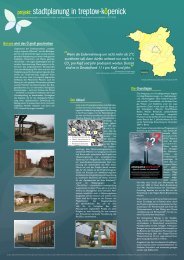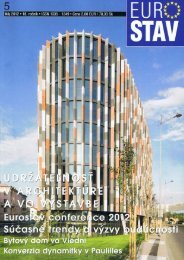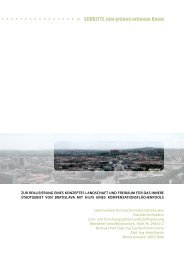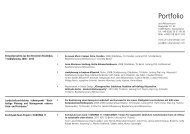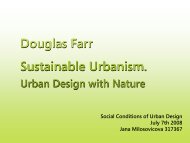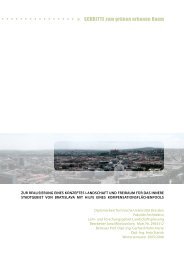Thesis document - Jana Milosovicova - Urban Design English
Thesis document - Jana Milosovicova - Urban Design English
Thesis document - Jana Milosovicova - Urban Design English
- No tags were found...
Create successful ePaper yourself
Turn your PDF publications into a flip-book with our unique Google optimized e-Paper software.
effect of a water body reaches into considerably higher distancecompared to the of an enclosed water body (Sukopp and Wittig1998, p. 162).Local air circulationFig. 52 Extended access balconies that connectsingle-standing buildings allow ventilationwhile creating a “compact urban block” structure,Bozen, South Tyrol (www.provincia.bz.it)• Support autochtonous local air circulation within a singlebuilding block and the adjacent open space, where no superiorventilation channels are present. For this, wind permeability ofbuilding blocks is to be provided (fig. 42).• Open buildings and urban blocks to provide ventilation indense urban areas. Involve extended access balconies connectingsingle standing buildings instead of built corners (fig. 52), andopenings in buildings and in urban blocks (fig. 53) to enhancelocal air circulation 38 where a solid, compact urban block structureis required (such as in dense urban cores).• Involve architecture on stilts to enhance the near-ground ventilation(besides enhancing evapotranspirative ground area) (fig. 54);Street ventilation• Orientate streets parallel to wind direction (or in a small angle)to optimize wind flow and thus aid in cooling that area of the city.Fig. 53 Openings in compact urban blocks forbetter air circulation• Widen streets to support turbulent ventilation where higherwind speed is desired (unless oriented in the prevailing wind direction,where the wind speed is higher and thus a narrower streetprofile suffices). To lover the pollution loads in the streets, it isrecommended to provide these with pollutant-absorbing façade- orhigh tree vegetation.• Take advantage of the venturi-effect – design open spaces triangle-liketo enhance wind speeds.• Use façade greening instead of tall trees in the streets wherestrong ventilation effect is desired (Wong and Chen 2009, p. 32).However, use robust tree vegetation where wind blocking isdesired, for instance in pedestrian areas (Givoni 1998, p. 297).• Involve flat roofs to enhance ventilation at the street level (fig.55).Fig. 54 Architecture on stilts enables betterventilation near the ground and enhances thepervious areaSolar radiationTransform incoming solar radiation into latent heat as themain priority• via evapotranspiration of water, see ‘Water cycle and Vegetation’.Albedo• Reduce local surface temperatures through the use of reflective andlight-coloured (high albedo) surfaces;• Apply the albedo measure additionally to greening means, at spotswhere vegetating is not possible (such as in case of roads and side-Fig. 55 Flat roofs enhance ventilation at thestreet level (Flickr: nicolasnova)38 This measure also helps to prevent excessive humidity and deterioration of buildingsdue to walls’ wetness, especially when the buildings and courtyards arerichly planted with vegetation.42Climate Sensitive <strong>Urban</strong> <strong>Design</strong> in Moderate Climate Zone: Responding to Future Heat Waves. Case Study Berlin Heidestrasse/Europacity



